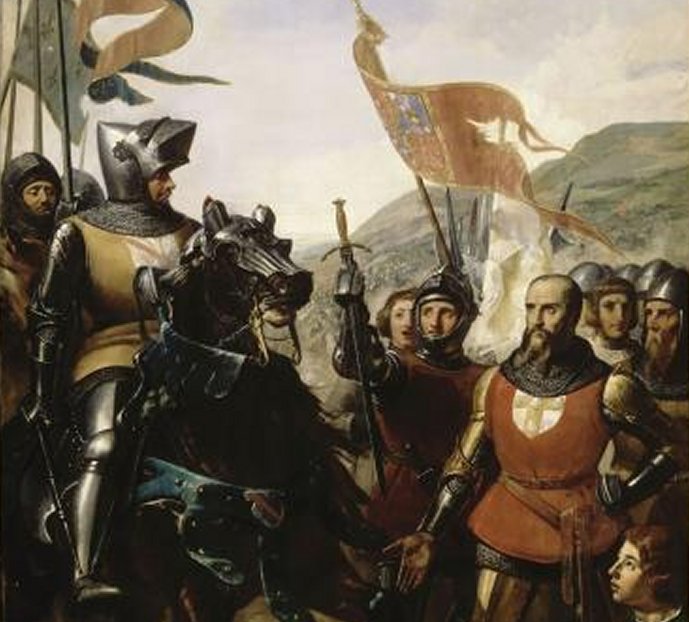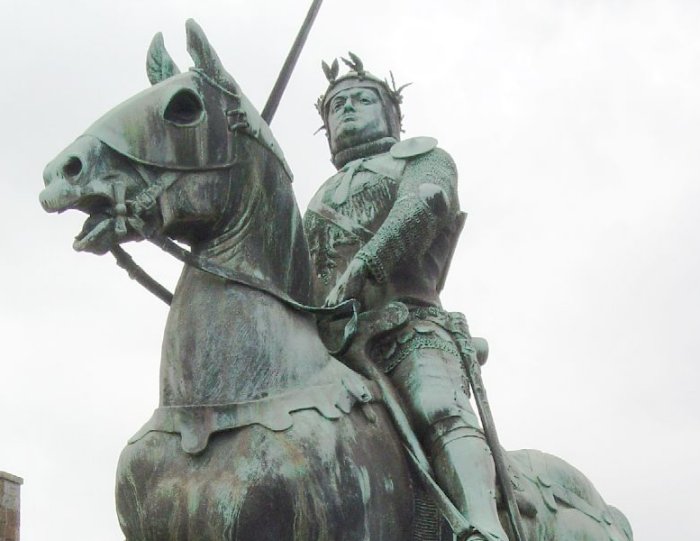Bertrand du Guesclin: ‘Eagle Of Brittany’ Brave, French Commander And His Clash With Sir Thomas Of Canterbury
A. Sutherland - AncientPages.com - Bertrand du Guesclin (c. 1320 – 1380) was the son of a poor knight from Brittany. He was known by nicknames: "The Eagle of Brittany" or "The Black Dog of Brocéliande."
Guesclin at the Battle of Cocherel. Image credit: Charles-Philippe Larivière - CC BY-SA 3.0
Bertrand had not a happy childhood, mainly because he early learned to hate his violent father.
This man wasn't a handsome man. He was far from the kind of man we usually think of as a knight, at least in appearance. Everyone who met him seemed to agree on his unique ugliness. His body was short-grown and square-shaped, and his head was more than usually round. His arms were disproportionately long.
Bertrand And His Trusty Companions In Brocéliande Forest
In the 1340s, the Duchy of Brittany was plagued by a victorious civil war. The old duke's half-brother Charles de Blois, and his niece Jeanne de Penthiévre raved about who could take over.
Jeanne gathered a large group of fighters who would act as guerrilla warriors. Among them was also Bertrand du Guesclin. He bought enough weapons and armor for a smaller group of reliable men by selling his mother's jewels.
Bertrand and his trusty companions hid in the Brocéliande Forest, a legendary enchanted forest that, among medieval Europeans, was imagined as a place of magic and mystery. The forest was believed to be somewhere in Brittany, but its location was never established. Probably the site was only a product of human imagination.
Merlin and Viviane in Brocéliande, Gustave Doré's illustration for Idylls of the King (1868). source
The knight, Bertrand du Guesclin, reminds us of Robin Hood, a legendary heroic outlaw, and a highly skilled archer and swordsman.
Bertrand, however, was an actual historical figure. With his band of fighters, he organized quick and effective attacks, returning safely to his hiding place in the forest.
Bertrand - Military Commander
Bertrand was a Breton knight and an important military commander, who was involved in the Breton War of Succession (1341–1364), Castilian Civil War (1351 - 1369), and the Hundred Years War (1337-1453).
From 1370 to his death, he was Constable of France for King Charles V. King Charles V was particularly impressed with Bertrand's resistance to the English in the siege of Rennes and took him into royal service.
Bertrand was a good and intelligent commander, but not all his military encounters with the enemy succeeded.
He was well known for his Fabian strategy, avoiding regular field battles, harassing the English troops through what is called modern guerrilla warfare, and effectively disrupting supplies of the enemy. He made a famous military career through sheer fighting skills.
He often took part in battles, where the fighting location and time were determined earlier, and won the four in which he held command. Despite many years of military service, Bertrand was dubbed a knight at the unusually high age of 34.
Incident With Sir Thomas Of Canterbury
In 1356, Bertrand was sent to the town of Rennes, which the Duke of Lancaster besieged. The English knight, Sir Thomas of Canterbury, captured Bertrand's little brother during a truce. Such an act was against the rules of war, and Bertrand immediately rode straight into the English camp. When Bertrand entered his tent, Sir Thomas was playing chess with an English knight, Sir John de Chandos. The brave Frenchman challenged Sir Thomas to a sword duel, and the latter didn't protest.
Statue of Bertrand du Guesclin in Dinan. Source
He was convinced that he would defeat this strange-looking intruder. Sir Thomas was wrong.
Bertrand did not add any other life-threatening injuries to his opponent, but he drew attention to his extraordinary sword-fighting skills. During the next half hour, however, he got into so much trouble that he could not go on for several days after this most unfortunate encounter with Bertrand, the knight.
Then he returned home with his abducted brother.
Bertrand was given many assignments, and many of them were victorious. In the Battle of Navarrete in 1367, for example, he was defeated by the Black Prince, a military genius who was a talented warrior. Often captured, then redeemed, Bertrand was known for his boldness and handled well the hostile captivity that he experienced frequently.
In 1380, however, he returned to the French king's service to fight the English but died on July 13. Bertrand du Guesclin was buried, on the command of King Charles V, in Saint-Denis, the burial ground of the French kings.
He was a highly skilled commander whose military capabilities contributed to France's successes, so he deserved an honorable royal burial.
Written by – A. Sutherland - AncientPages.com Senior Staff Writer
Updated on April 29, 2023
Copyright © AncientPages.com All rights reserved. This material may not be published, broadcast, rewritten or redistributed in whole or part without the express written permission of AncientPages.com
Expand for referencesReferences:
David F. Jameson Jameson, The life and times of Bertrand Du Guesclin
More From Ancient Pages
-
 Never-Before-Seen 16 Meters Long Ancient Egyptian Papyrus Unveiled To The Public
Artifacts | Feb 21, 2023
Never-Before-Seen 16 Meters Long Ancient Egyptian Papyrus Unveiled To The Public
Artifacts | Feb 21, 2023 -
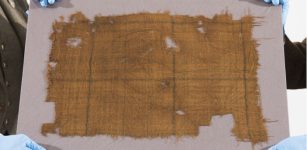 Scotland’s Oldest Tartan On Display For The First Time!
Artifacts | Apr 6, 2023
Scotland’s Oldest Tartan On Display For The First Time!
Artifacts | Apr 6, 2023 -
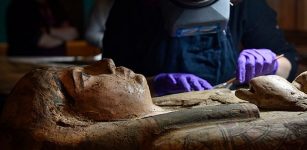 Never-Before-Seen 3,000-Year-Old Paintings Of Egyptian Goddess Amentet Discovered Inside Coffin Of A Mummy
News | Apr 7, 2020
Never-Before-Seen 3,000-Year-Old Paintings Of Egyptian Goddess Amentet Discovered Inside Coffin Of A Mummy
News | Apr 7, 2020 -
 Climate Played A Crucial Role In Human Migration From Africa – New Study
Archaeology | Dec 8, 2023
Climate Played A Crucial Role In Human Migration From Africa – New Study
Archaeology | Dec 8, 2023 -
 Did Ancient Romans Use Four-Meter Deep Shafts As Refrigerators During Summer?
Archaeology | Apr 6, 2018
Did Ancient Romans Use Four-Meter Deep Shafts As Refrigerators During Summer?
Archaeology | Apr 6, 2018 -
 Mystery Of Ancient Beehive Tombs Around The World
Featured Stories | Feb 28, 2016
Mystery Of Ancient Beehive Tombs Around The World
Featured Stories | Feb 28, 2016 -
 Mungo Man Finally To Rest In Peace After 42,000 Years – Reburial Approved After Federal Decision
News | Apr 8, 2022
Mungo Man Finally To Rest In Peace After 42,000 Years – Reburial Approved After Federal Decision
News | Apr 8, 2022 -
 Impressive Study Highlights Female-Led Migration Into Bronze Age Orkney And Wins Prestigious Award For 2023
Archaeology | Apr 4, 2023
Impressive Study Highlights Female-Led Migration Into Bronze Age Orkney And Wins Prestigious Award For 2023
Archaeology | Apr 4, 2023 -
 Unique Temple Of The Condor In Machu Picchu: 3D Spectacular Inca Stonemasonry
Civilizations | Sep 21, 2016
Unique Temple Of The Condor In Machu Picchu: 3D Spectacular Inca Stonemasonry
Civilizations | Sep 21, 2016 -
 Ancient Textile Mystery: King Canute Enshrined In His Own Clothes But Found In His Brother’s
Artifacts | Oct 5, 2020
Ancient Textile Mystery: King Canute Enshrined In His Own Clothes But Found In His Brother’s
Artifacts | Oct 5, 2020 -
 Archaeological Site Along The Nile Reveals The Nubian Civilization That Flourished In Ancient Sudan
Civilizations | Apr 14, 2022
Archaeological Site Along The Nile Reveals The Nubian Civilization That Flourished In Ancient Sudan
Civilizations | Apr 14, 2022 -
 On This Day In History: Fascinating Prague Astronomical Clock Mentioned For The First Time – On Oct 9, 1410
News | Oct 9, 2016
On This Day In History: Fascinating Prague Astronomical Clock Mentioned For The First Time – On Oct 9, 1410
News | Oct 9, 2016 -
 Tiger Cave: Rock-Cut Hindu Temple Complex Dated To East India’s Pallava Empire
Featured Stories | Jan 19, 2017
Tiger Cave: Rock-Cut Hindu Temple Complex Dated To East India’s Pallava Empire
Featured Stories | Jan 19, 2017 -
 Sacred Artifact With Mystical Powers – The Discovery – Part 2
Artifacts | Apr 26, 2019
Sacred Artifact With Mystical Powers – The Discovery – Part 2
Artifacts | Apr 26, 2019 -
 On This Day In History: Johannes Kepler ‘Father Of Modern Astronomy’ Was Born – On Dec 27, 1571
News | Dec 27, 2016
On This Day In History: Johannes Kepler ‘Father Of Modern Astronomy’ Was Born – On Dec 27, 1571
News | Dec 27, 2016 -
 On This Day In History: The Gregorian Calendar Implemented – On Oct 5, 1582
News | Oct 5, 2016
On This Day In History: The Gregorian Calendar Implemented – On Oct 5, 1582
News | Oct 5, 2016 -
 Famous Viking Sigurd Snake-In-The-Eye, Son Of Ragnar Lodbrok And The Mark Of Fafnir Prophecy
Featured Stories | Mar 16, 2018
Famous Viking Sigurd Snake-In-The-Eye, Son Of Ragnar Lodbrok And The Mark Of Fafnir Prophecy
Featured Stories | Mar 16, 2018 -
 Rök Stone (Rök Runestone): Longest Runic Inscription Ever Discovered
Featured Stories | Jun 12, 2024
Rök Stone (Rök Runestone): Longest Runic Inscription Ever Discovered
Featured Stories | Jun 12, 2024 -
 Why Is Roulette Called The Devil’s Game?
Ancient History Facts | Apr 3, 2018
Why Is Roulette Called The Devil’s Game?
Ancient History Facts | Apr 3, 2018 -
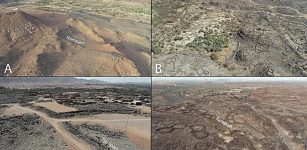 Vast Fortification Enclosing Walled Oasis Dating Back 4,000 years In North-Western Arabia – Unearthed
Archaeology | Jan 10, 2024
Vast Fortification Enclosing Walled Oasis Dating Back 4,000 years In North-Western Arabia – Unearthed
Archaeology | Jan 10, 2024

